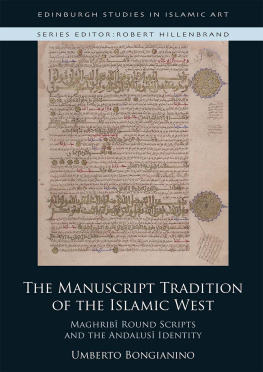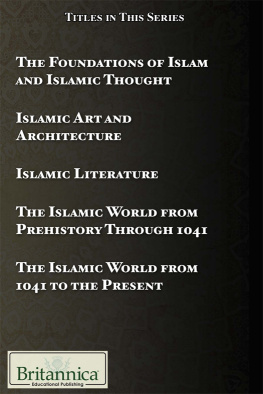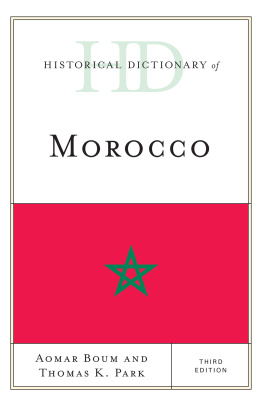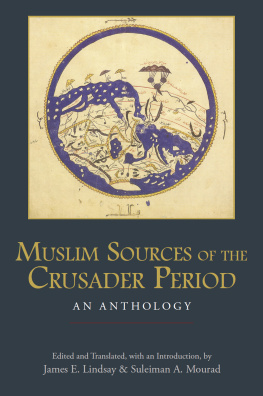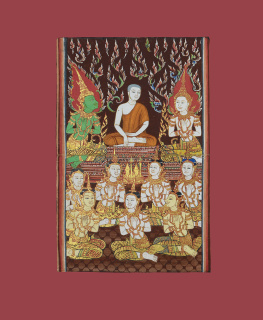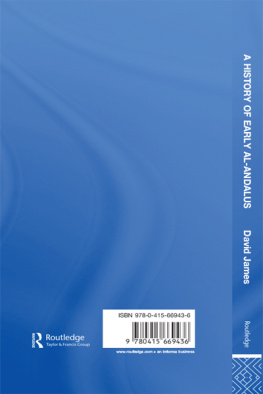Contents
Print Page Numbers

THE MANUSCRIPT TRADITION OF THE ISLAMIC WEST
Edinburgh Studies in Islamic Art
Series Editor: Professor Robert Hillenbrand
Advisory Editors: Bernard OKane and Scott Redford
Series titles include:
Isfahan and its Palaces: Statecraft, Shiism and the Architecture of Conviviality in Early Modern Iran
Sussan Babaie
The Making of the Artist in Late Timurid Painting
Lamia Balafrej
Text and Image in Medieval Persian Art
Sheila S. Blair
The Minaret
Jonathan M. Bloom
The Manuscript Tradition of the Islamic West: Maghrib Round Scripts and the Andalus Identity
Umberto Bongianino
Reframing the Alhambra: Architecture, Poetry, Textiles and Court Ceremonial
Olga Bush
The Seljuqs and their Successors: Art, Culture and History
Edited by Sheila R. Canby, Deniz Beyazit and Martina Rugiadi
The Wonders of Creation and the Singularities of Painting: A Study of the Ilkhanid London Qazvn
Stefano Carboni
The Making of Islamic Art: Studies in Honour of Sheila Blair and Jonathan Bloom
Edited by Robert Hillenbrand
Islamic Manuscripts of Late Medieval Rum, 12701370: Production, Patronage and the Arts of the Book
Cailah Jackson
Islamic Chinoiserie: The Art of Mongol Iran
Yuka Kadoi
Rum Seljuq Architecture, 11701220: The Patronage of Sultans
Richard P. McClary
Medieval Monuments of Central Asia: Qarakhanid Architecture of the 11th and 12th Centuries
Richard P. McClary
The Dome of the Rock and its Mosaic Inscriptions
Marcus Milwright
Meaning in Islamic Art: Studies in Honour of Bernard O'Kane
Heba Mostafa
The Shrines of the Alids in Medieval Syria: Sunnis, Shiis and the Architecture of Coexistence
Stephennie Mulder
Rumi A Life in Pictures
John Renard
Chinas Early Mosques
Nancy Shatzman Steinhardt
edinburghuniversitypress.com/series/esii
THE MANUSCRIPT TRADITION OF THE ISLAMIC WEST
MAGHRIB ROUND SCRIPTS AND THE ANDALUS IDENTITY
UMBERTO BONGIANINO

Edinburgh University Press is one of the leading university presses in the UK. We publish academic books and journals in our selected subject areas across the humanities and social sciences, combining cutting-edge scholarship with high editorial and production values to produce academic works of lasting importance. For more information visit our website: edinburghuniversitypress.com
Umberto Bongianino, 2022
Cover image: Al-Bukhr, Al-Jmial-a. Copied and illuminated in 591/1195, possibly in Marrakesh. Paper, 33.5 24.5 cm.
Istanbul, Topkap Palace Library, ms. A. 240, f. 3b. c Milli Saraylar daresi Bakanl.
Cover design: Stuart Dalziel
Series design concept: Cathy Sprent
Edinburgh University Press Ltd
The Tun Holyrood Road
12 (2f) Jacksons Entry
Edinburgh EH8 8PJ
A CIP record for this book is available from the British Library
ISBN 978 1 4744 9961 3
The right of Umberto Bongianino to be identified as author of this work has been asserted in accordance with the Copyright, Designs and Patents Act 1988 and the Copyright and Related Rights Regulations 2003 (SI No. 2498).
Contents
APPENDICES
Figures
Acknowledgements
The research that shaped this book would not have been possible without the support, advice and encouragement of many scholars to whom I owe an infinite debt of gratitude, both intellectual and personal. My doctorate at the University of Oxford (201317) was marked by the exemplary guidance of Jeremy Johns, my academic supervisor at the Khalili Research Centre, and by the insightful comments and constructive criticism of my examiners Franois Droche, Maribel Fierro, Tim Stanley, Emilie Savage-Smith and Alasdair Watson. However, this book is also the result of the fruitful conversations I have had the privilege to entertain, either remotely or in person, with countless colleagues from all over the world, and especially with Cyrille Aillet, Juan Pablo Arias Torres, Mara Luisa vila, Arafat Aydn, Nourane Ben Azzouna, Pascal Bursi, Claudia Colini, Arianna DOttone, Abdelaziz Essaouri, Jean-Louis Estve, Alain George, Konrad Hirschler, Nadia Jamil, Mustapha Jaouhari, Alya Karame, Mykls Murnyi, Pter Tams Nagy, Judith Olszowy-Schlanger and Marina Rustow. Finally, my profound appreciation goes to the directors, curators and staff of more than sixty libraries and museums, without whose help I could never have examined the manuscripts here discussed nor obtained the images that illustrate this book. Among them are Yasemen Akcay (K), Colin Baker (BL), Nouzha Bensaadoune (BNRM), Ahmed-Chaouqi Binebine (Rabat, Royal Library), Abdelfattah Boukchouf (Fes, Qarawiyyn Library), Esra Myesserolu (Istanbul, Topkap Palace library), Nahla Nassar (The Khalili Collections), Maria Jos Rucio Zamorano (BNE), Jun Snchez Ocaa (Granada, Sacromonte Library), Marc Pelletreau (Doha, Islamic Art Museum), Sidi Slimane (Zaouiat Sidi Hamza, Library of the Zwiya Ayyshiyya), Rachida Smine (BNT), Jos Luis del Valle Merino (RBE), Elaine Wright (CBL) and Sabahattin Yargul (Ankara University Library).
To the people mentioned above and many others who have assisted my research over the past eight years I offer this book as a modest token of my gratitude, hoping that they may recognise in it the fruits of the seeds they sowed and forgive the inevitable errors and omissions for which only I am to blame. I dedicate anything useful or interesting that may be found in the following pages to my students, and to all curious and patient readers, few as they may be.
Note on Transliteration and Translation
The transliteration system for Arabic followed in this book is that of the International Journal of Middle Eastern Studies (IJMES), with its mixed use of digrams and diacritics. Case endings and suffixed short vowels are not expressed in transliteration, except for poetry and the indefinite accusative; in these cases, they are indicated with superscript letters (e.g. taslman). The final short vowels of demonstratives, prepositions and certain fixed expressions are also omitted (e.g. dhlik, hdhih, tat, Allhumm). The alif of the definite article al- is usually not omitted, except when prefixed with a conjunction or preposition (e.g. wa-l-kitb, bi-llh), as well as in poetry, where it is replaced by an apostrophe. In transliterations from manuscripts, indicates scriptio defectiva in words that are also found written in scriptio plena (e.g. thalth, Sha bn, lamn, Hrn); if a word is never found written in scriptio plena then is not used (e.g. ramn, hdh, dhlik, Allh). Accusative and possessive suffixes are separated from the stem words by hyphens, except for the first-person singular (e.g. kitbu-hu, but kitb). Arabic names of persons, deities, tribes, dynasties, months, days of the week, cities, regions, institutions and book titles title are always capitalised in transliteration.
When anglicised, Arabic names of dynasties are not provided with diacritics (e.g. Nasrids, not Narids), and hamza, ayn and long vowels are not marked (e.g. Abbadids, not Abbdids). The same applies to the adjectives derived from these names, and to other anglicised adjectives such as Quranic and Kufic, which have entered the common usage. Arabic princely and religious titles (sultan, emir, vizier, imam, etc.) are also given according to their anglicised form, when available. Names of cities are given according to their English exonym, when available (e.g. Cordova, not Crdoba or Quruba; Kairouan, not al-Qayrawn). In the transliteration of Arabic names within the English text, the words

